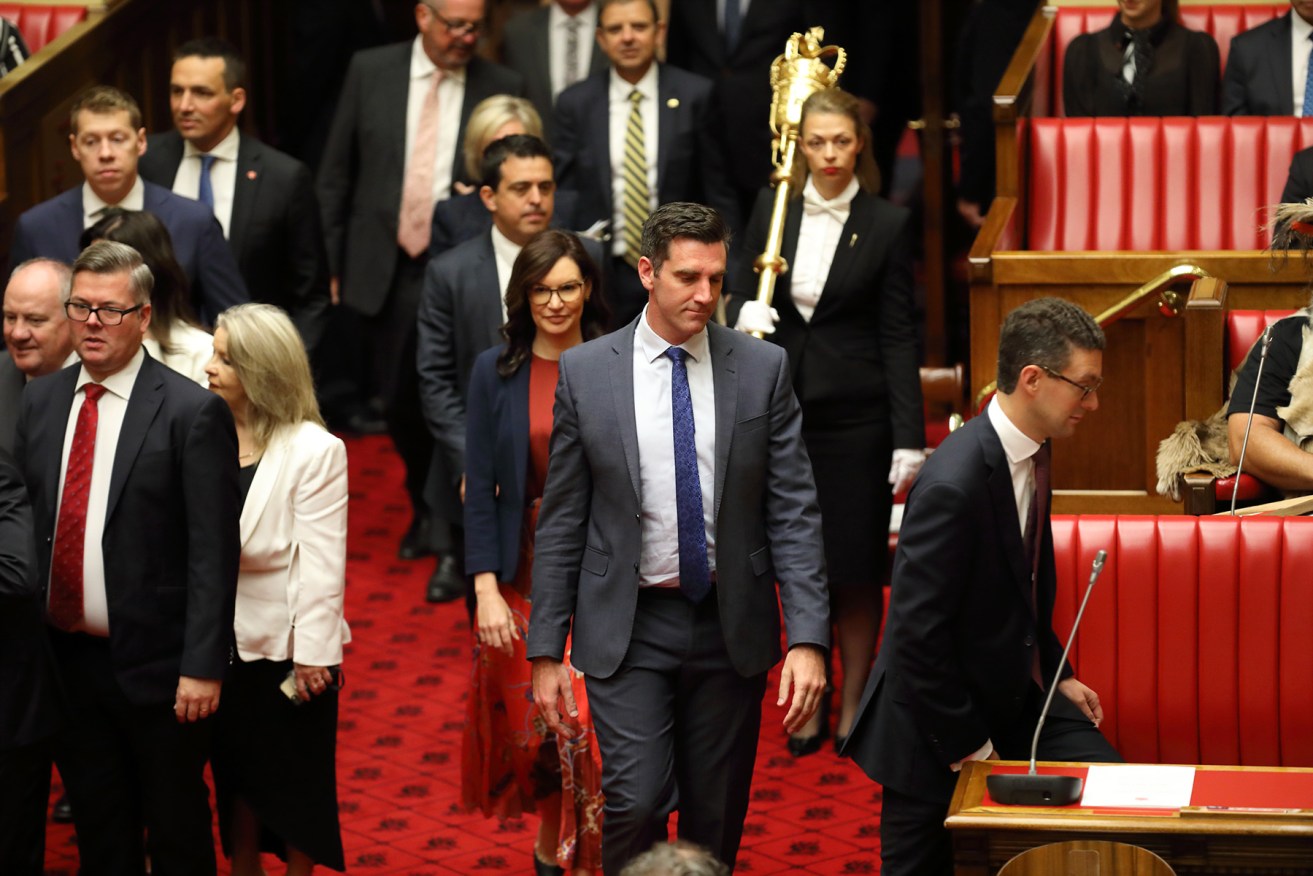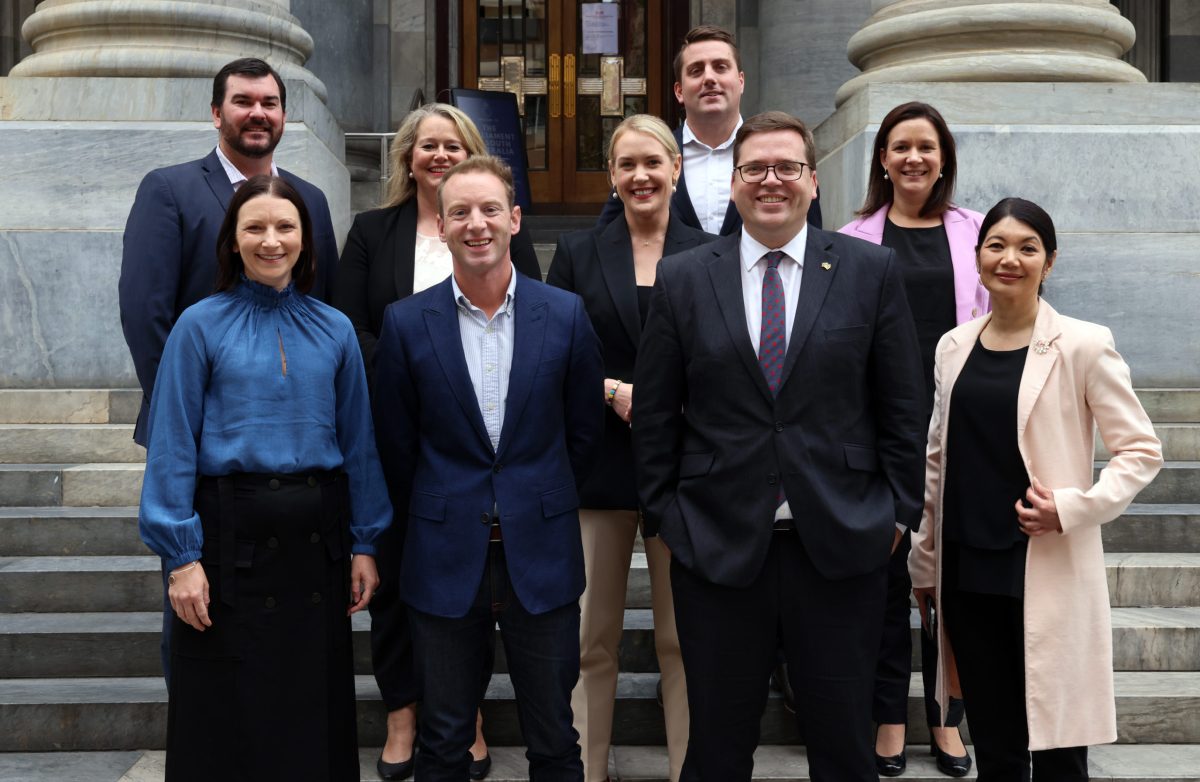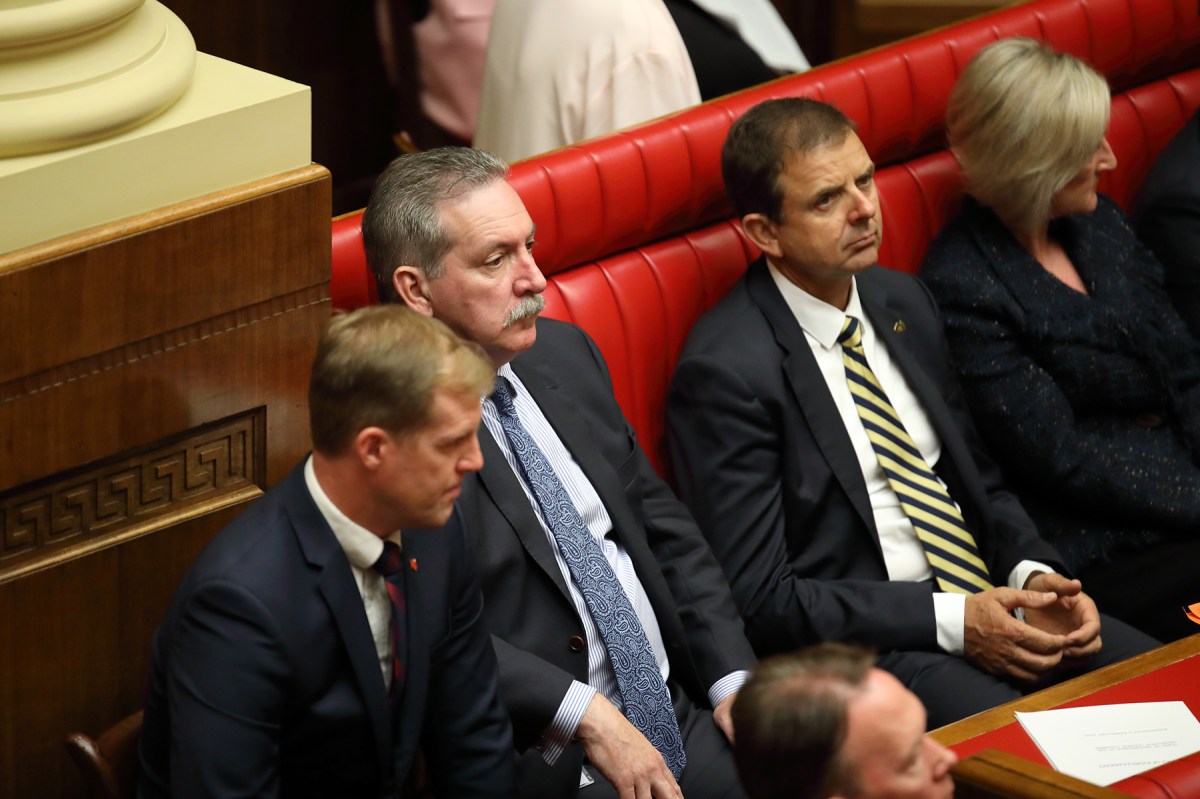Richardson: Should the Liberals split to save themselves?
With the state Liberals set for a period of internal reform, Tom Richardson considers an option that could help solve one of the party’s most fundamental divisions.

Then-Liberal MPs Fraser Ellis and Dan Cregan at parliament's reopening in 2020. Both are now on the crossbench. Photo: Tony Lewis / InDaily
The first major sign that the Marshall Liberal Government was in serious electoral trouble – at least, for anyone who hadn’t been watching it particularly closely since about mid-2018 – was probably a Newspoll published in the Australian newspaper three weeks before the March 19 polling day.
Despite a dearth of published polls, there were already warning signs – an earlier Australia Institute-commissioned Dynata poll had given Labor a narrow lead, flipping the 51-49 result that had favoured the Liberals only a few months earlier. That equivalent survey in September 2021 was, nonetheless, a troublingly tight result given the government was, at the time, near the apex of its COVID-response approval.
But the Newspoll – putting the government six points behind Labor, 47 per cent to 53 – was the first published evidence that voters weren’t merely not sold on the SA Liberals; they were actively shopping for alternatives.
But perhaps, in hindsight, the more serendipitously telling aspect of the Oz poll was the fact that on initial publication it made the mistake of shoehorning the survey data into the newspaper’s standard Newspoll template: in doing so, assigning the 47 per cent two-party voting intention not to Marshall’s SA Liberal Party but to “the Coalition”.
Which naturally prompted the odd pedant (ok, me) to point out that the Libs aren’t actually in a Coalition in SA, and indeed that the last Nationals MP to sit in state parliament was a member of the Rann Labor cabinet.
But the more I reflect on the aftermath of March 19, the more it occurs to me that this inadvertent gaffe might in fact offer a solution to one of the state Libs’ most enduring problems.
It’s a problem that has existed – sometimes starkly – for generations, bound up in, and reflected by, the more obvious issue of that old chestnut that is factional internecine strife.
But it goes beyond that: the reality is that the Liberal Party is simply trying to be two political movements at once.
Witness new Liberal leader David Speirs’ talking points, first last week when he announced his candidacy, and again after his decisive party-room victory.
He wants to reach out to small business, but also regional communities – all while maintaining a personally social conservative outlook and pursuing an unapologetically progressive environmental agenda.
I mean, these are all noteworthy pursuits, but they hang together about as cogently as the motley assortment of portfolios Speirs assigned himself in yesterday’s shadow cabinet unveiling: he’s kept Environment (despite last year bemoaning that he was actually rather keen for a new, um, environment) while also taking on “Small and Family Business” and oversight of the Public Service and Disability.

David Speirs with some of his new shadow cabinet members yesterday. Photo: Tony Lewis / InDaily
Navigating that complex array of portfolios appears about as logical as trying to sell a cogent vision that will concurrently appeal to both metro voters – who will ultimately determine the next election – and country communities.
After his firm kwp! created the campaign pitch that helped cruel Labor’s federal hopes in 2019, Adelaide ad-man David O’Loughlin noted a distinct feature of federal campaigns is “the nuances between the states and regions”.
Federally, those nuances played poorly for Labor, which is still trying to work out if it is the Workers Revolutionary Party or the Greens – a clean energy focus, for instance, plays well in the Melbourne metro, but was a vote-killer in Queensland.
It was a similar tale for the Libs at state level (where a very similar campaign pitch didn’t play out anywhere near as well): the mining Bill, in effect, was a symbol of a running theme that ultimately manifested in the most remarkable individual seat result on polling day.
Geoff Brock, the man who had established a select committee into mining access rights for farming land, took on Dan van Holst Pellekaan, the minister who had championed the legislation that prompted the inquiry.
The result in Stuart wasn’t even close.
While the SA Libs’ intractable issue has existed for generations, it was not as readily apparent in Opposition – save for the odd moment of policy and ideological confusion, such as when Marshall agreed to then-Liberal MP for Mount Gambier Troy Bell’s demand for a moratorium on fracking in the south-east, which sat uneasily beside the Libs’ otherwise perpetual mantra of “backing business to grow the economy”.
In Government though, the gulf became profound.
This all stemmed from the inability of the Liberal Country League to coexist with the moderate Liberal Movement
Before the Marshall administration’s first year was out, four of its backbench MPs had crossed the floor in opposition to its proposed mining Bill, arguing it encroached on the pastoral rights of farmers.
Events have since transpired, in various ways, to cement those party divisions: two of those four MPs (Fraser Ellis, and Dan Cregan) now sit on the crossbench, another (Steve Murray) lost his seat. The fourth, Nick McBride, having pondered quitting the party, instead ran for its leadership this week, managing one vote – enough, though, to see him elevated to be Shadow Parliamentary Secretary for Regional Engagement. Which, in an informal sort of way, he kinda was already.

McBride with Murray (left) in 2020. Photo: Tony Lewis / InDaily
And a crucial role it will be too. For at the election, the party, as broadly observed, got kicked in the nether-regions by the regions.
The Libs not merely forfeited Stuart, Kavel and Narungga to independents (albeit all incumbents), having previously lost Mount Gambier to Bell after his ICAC-imposed exile, it endured heavy swings in the likes of Finniss, Flinders and Hammond.
The factional warfare flared last year after the moderate-run Marshall Government was seen to play a key role in passing socially-progressive legislation, including conscience votes on euthanasia and abortion.
Despite Marshall himself famously once declaring he didn’t get into politics for the social issues, it’s not a stretch to suggest his government was arguably the state’s most socially progressive since that of the premier after whom his seat is named.
And with a focus on a poorly-spruiked city arena and the scrapping of the V8 car race to appease the burghers of eastern Adelaide, it’s hardly surprising regional South Australians – let alone those in the outer suburbs – failed to see an administration governing in their interests.
For that old chestnut of internecine warfare, one solution that has been suggested – and Speirs concedes on InDaily’s Notes On Adelaide podcast published today that he’s open to it – is formalised factions: officially splitting the party’s MPs into two groups.
For the broader, but related problem, of conflicting agendas between the regions and metropolitan Adelaide, perhaps there is a similar solution: splitting into two parties.
After all, that’s where this all stemmed from in the first place: the inability of the Liberal Country League to coexist with the moderate Liberal Movement.
Federally, and in other states, the National Party as a junior Coalition partner soaks up some of the angst perpetuated in regional areas by the frequent city-centrism that necessarily comes with actually governing.
In SA, the Nationals are a minor concern, having recently rallied to avoid deregistration altogether, and polling below the Greens in regional seats such as Flinders and Hammond.
But a Coalition spat over policy is far less damaging than an internal Liberal one: and if the Libs intend on not merely returning to government one day, but actually making something of it, they need to find a way to reconcile their natural constituencies.
If they don’t, the voters will find a way on their behalf – as they did last month.
Narungga may have turned independent because of an ICAC inquiry, but its voters confirmed it as such because they felt more suitably represented by someone who shared their conservative values but sat outside the Liberal Party.
This should be a devastating reality-check for the party – and it won’t be resolved simply by convincing Fraser Ellis to return to the fold.
After all, we’ve seen all this before, with Peter Lewis, with Mitch Williams, with Rory McEwen, with Don Pegler, with Geoff Brock, with Karlene Maywald.
The Libs assume a stranglehold on those safe regional seats that they so often complain are locking up their votes in electorates that prevent them from winning government.
The reality, though, is that time and again, when voters in those seats are given a credible alternative – or even a less-than-credible one – they’ll jump at it.
Instead of trying to shoehorn two parties into one, perhaps it’s time for the Libs to consider a regional rebrand, and a formalised coalition – allowing their regional MPs the capacity to advocate against party policy without blowing the joint up.
Mid-last year NewsCorp reported that frustrated conservatives were musing about the prospect of re-forming the LCL – a symbol of festering frustration with Marshall’s moderates.
Nothing more came of it – but it’s well worth giving due consideration.
And not to thwart the Liberal Party, but to save it.
Tom Richardson is a senior reporter at InDaily.




